A little bit of BBD Bag, a whole lot of Calcutta
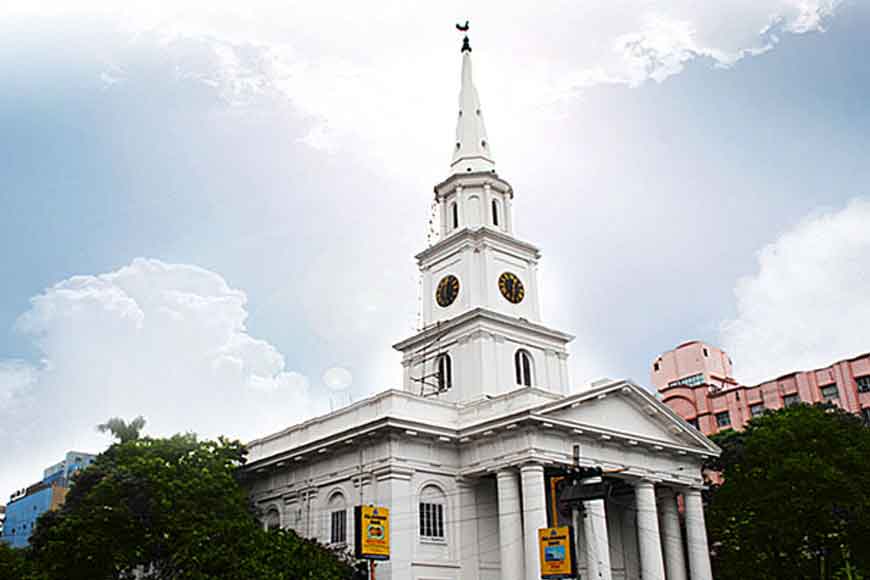
In the second episode of our walking tour of Kolkata, we cover the rest of the BBD Bag area, where we started out last week. As it was last time, the route this time is short and crisp, beginning from St Andrew’s Church, which we visited last time. Not too much heavy walking, but just enough to make it enjoyable. If you can, try and imagine what the heritage structures you will come across, and their surroundings, must have been like when they were created, at the height of Calcutta’s fame and prosperity as a ‘British’ city.
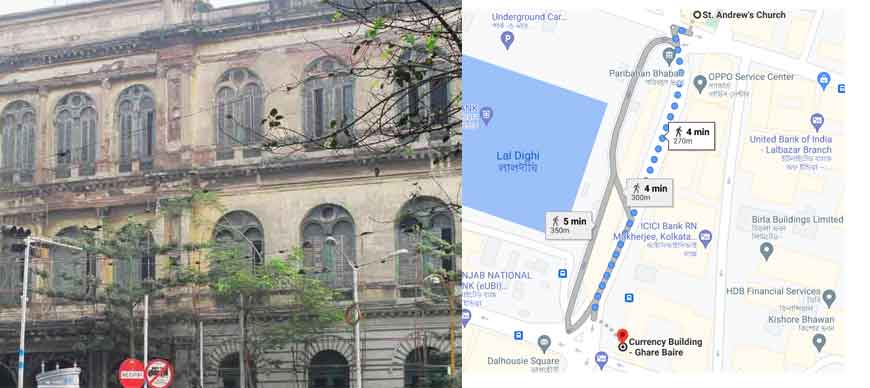
Point A - Old Currency Building
The Currency Building is an early 19th-century structure at the intersection of Old Court House Street (which leads down from St Andrew’s) and Surendra Mohan Ghosh Sarani. The building’s main façade faces west toward BBD Bag, and Lal Dighi is roughly 100 metres to its northwest. Originally built in 1833 as the Calcutta branch of Agra Bank, it was converted for use by the Office of the Issue and Exchange of Government Currency in 1868. From 1935-37, the Reserve Bank of India (RBI) used the building as its first central office. Later, it became a storehouse for the Central Public Works Department (CPWD), before authorities decided to demolish it entirely in 1994, owing to structural safety concerns.
How this magnificent three-storey mansion escaped that terrible fate is a story by itself. Suffice it to say that demolition work began in 1996 and continued until 1998, by which time three of the domes over the central hall had been reduced to rubble, but the Indian National Trust for Art and Cultural Heritage (INTACH) and the Kolkata Municipal Corporation stepped in at this point to halt further damage. In 2003, the building’s custodianship passed to the Archaeological Survey of India (ASI), which renovated it from 2005-19, while simultaneously using it as regional headquarters. On January 11, 2020, Prime Minister Narendra Modi formally dedicated and reopened the building as primarily a museum.
The Italianate structure consists of floors made of marble and Chunar sandstone, and its main entrance features a three-part gate made of wrought iron. The central hall, now an open-air courtyard since its domes were demolished, once contained exchange counters for banknotes, gold, silver, and small change. During renovation, the hall was reorganised as a space for open-air events.
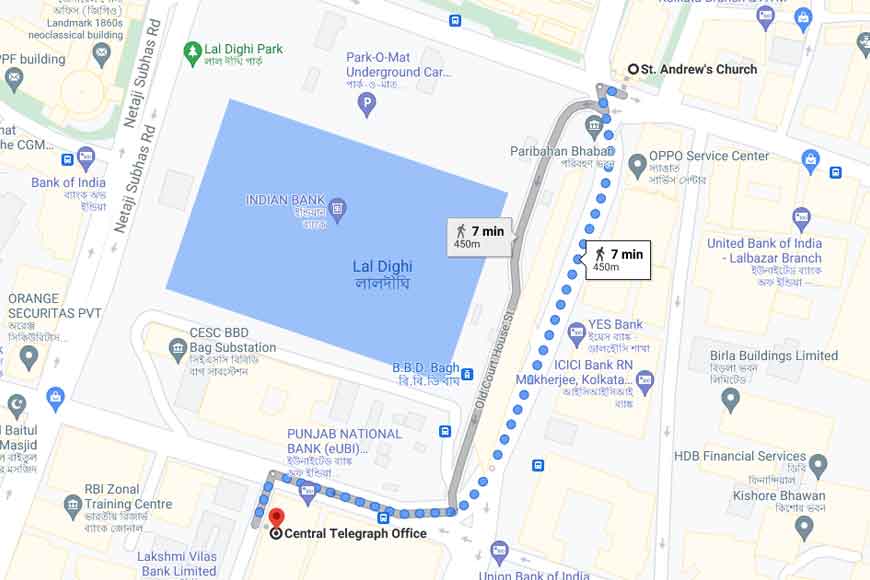
Point B - Postal Sorting & Central Telegraph Offices (CTO)
Crossing the road to the right from the Currency Building, you will come face to face with the Returned Letter-Postal Sorting and Central Telegraph offices. It is a testament to how gorgeous the twin stone buildings are, that despite the passing of time, and the myriad hawkers who overrun their wide corridors and alcoves, they are still such an imposing presence in the area.
Of course, both buildings do not date back to the same time. The older of the two came up a few years after the Battle of Plassey in 1757, when a large old pond was filled up by its owner, the infamous auctioneer William Tulloh, who began his auction mart at this location. In 1770, the government purchased the property and it was handed over to Hindustan Bank, the first European style bank in India, and three other businesses. Almost a century later in 1868, the ground was cleared for a new construction which was to become the original CTO, with its 120-foot tall tower. After a few holdups, construction was finally completed in 1876, and the building is today popularly known as the Dead Letter Office.
The new wing of the CTO was constructed in 1914, the year that World War I began. Considered a state-of-the-art institution at the time, the telegrams, telephones and facsimile messages sent from and received at this office linked Calcutta with the world. The lower floors of the building are now used to sort and store mail, while the upper floors have been converted into a guest house for postal employees, with many items of furniture dating back to over a century ago.
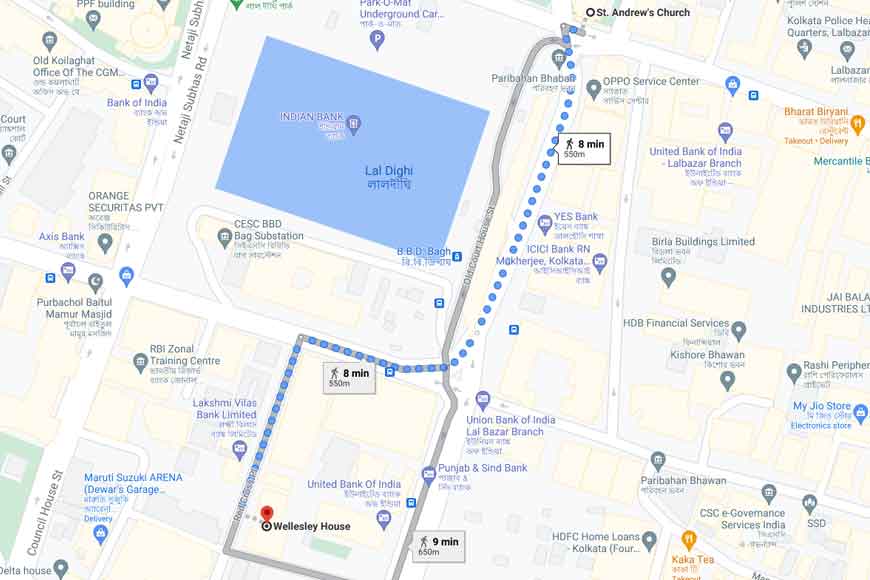
Point C - Wellesley Place
Wellesley Place is now Red Cross Place. Turning right from Old Court House Street, you will see the Standard Life Assurance Building or simply Standard Building. The man who designed this splendid edifice, Frederick William Stevens, also designed Mumbai’s famed Victoria Terminus or VT railway station, since renamed Chhatrapati Shivaji Terminus. Construction of the Standard Building began in 1894 and ended in 1896. Magnificent yet elegant, the structure is made truly outstanding by some of the most beautiful relief sculptures to be found on any British architecture anywhere in India.
The building was once home to the Life Insurance Company of Scotland, established in 1825, and the name was changed to Standard Life Assurance in 1832. If it is still so very impressive, despite the shabbiness and immense tangles of cables surrounding it, imagine what a sight it must have been in its heyday. The two wings of the three-storeyed building are joined by a small bridge which passes over Vansittart Row, where once stood the head office of renowned arms dealer Rodda & Co, a name which became familiar to every Calcuttan in 1914 thanks to the ‘Rodda Arms Heist’ carried out by members of the Bengali revolutionary organisation Anushilan Samiti.
The Standard Building still has its exquisite cupola and weathervane too. There are also two figures on the walls just below the archway at the main entrance, that of a young lady carrying a lamp symbolising life, and the Grim Reaper with a skull, representing death. Appropriately for an insurance company, these two form its official logo.
Once rundown and shabby, the building has been partially restored and renovated in recent years, with a new coat of paint and the removal of decades of dirt and grime. Thankfully, most of the relief sculptures are still in good shape, so catch them while you can.
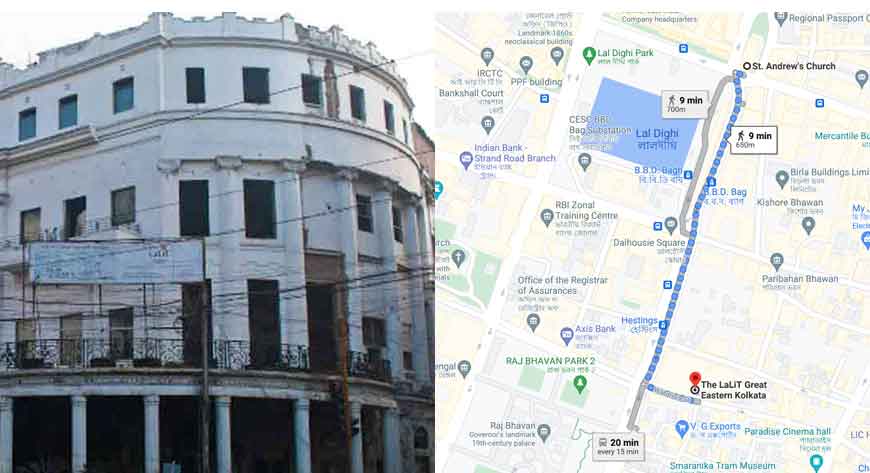
Point D - Great Eastern Hotel
Walking down from Red Cross Place toward Raj Bhavan, you will pass a group of lovely stone buildings on either side of the road. These were built in 1912 to house the stables of the Viceroy, along with several junior staff members. While the façades of the buildings remain as they were a century ago, the interiors now house a maze of staff quarters for Raj Bhavan employees.
Keep walking with the Raj Bhavan to your right, and you come upon the grand old lady of British Calcutta, the Great Eastern Hotel, now the Lalit Great Eastern Kolkata. Established in 1840 or 1841, the hotel was once referred to as ‘the Jewel of the East’, and began life under the ownership of a baker named David Wilson as the Auckland Hotel, named after Lord Auckland, then Governor General of India. In 1883, Auckland became the hotel in India to have its premises electrified.
Originally containing 100 rooms, the Auckland was expanded in the 1860s and its managing company renamed as Great Eastern Hotel Wine and General Purveying Co, among the first companies to have an Indian on its board of directors, in 1859. It finally became the Great Eastern Hotel in 1915, and went on to host international personalities including Nikita Khrushchev and Nikolai Bulganin, Queen Elizabeth II, Mark Twain, Dave Brubeck, and Ho Chi Minh.
Until its closure for restoration in 2005, Great Eastern was the longest continuously operating hotel in Asia. Sold to a private company in 2005, it reopened in November 2013.
Next week, we will walk in and around Esplanade. Until then, happy walking!










